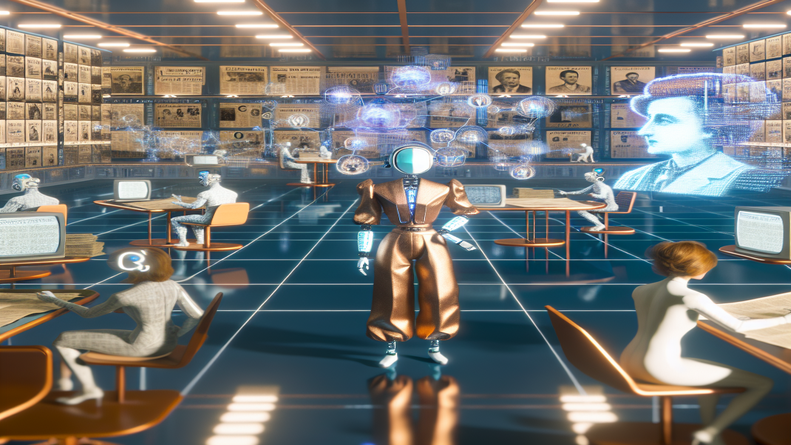Imagine living in a world where journalism is much more than a mere recorder of events; it is a consistent source of innovation. The world is already witnessing such a change, with AI-powered tools controlling the realms of media, and offering innovative solutions to complex problems. So, the question here is, can these AI journalism tools serve as a persistent source of evolution in news creation? Can an individual or a company harness the power of AI to reshape the landscape of journalism that generates massive engagement every month? This blog post sheds light on these questions and offers an inspiring roadmap for aspiring digital journalism pioneers.
🌱 The Journalistic Roots: Tapping into the Historical Archives
There was once a time when journalism was all about the hustle in newsrooms, the race against deadlines, and the tireless pursuit of sources. Traditional media giants like The New York Times not only witnessed history in the making but chronicled it with a finesse that was unmatched. Eons of reportage, millions of articles, and countless bytes of data have shaped the repository of such venerable institutions.
In the backdrop of this repository lies a new contender — artificial intelligence. As the algorithms got smarter, data from decades of journalism became the source code for training these digital scribes. Chatbots and AI-driven platforms emerged, silently sipping historical knowledge, learning the ropes of reporting from the repository of The Grey Lady itself. The transition from print to pixels has not been without its trials, with skepticism and debate closely treading on the heels of technological innovation.
🔍 The Ethical Enigma: When AI Reflects on Its Teachers
The deviation from archaic to advanced brought with it an intricate weave of ethical considerations. Who owns the vast wealth of historical information that has been fed to these silicon-based students? As these chatbots stepped out into the competitive world of journalism, they came armed with the wisdom of their predecessors, posing stimulating competition to the very archives they drew from.
The implications are profound and far-reaching. The AI, charged with the intellect of millions of past articles, steps into the limelight, ostensibly ready to outshine its trainers. This pivot point, where AI begins to hold its ground against established media, marks a critical juncture in journalism. It is a testament to human ingenuity, yet it flirts with the boundaries of intellectual property and fair use.
📈 The Surge of Synthetic Scribes: Charting the Progress
 Surpassing the initial hurdles, these AI chatbots did not just mimic; they evolved. Clad in the power of machine learning and natural language processing, they began churning out articles, summaries, and reports with an accuracy and speed that were hard to match by human standards. The surge was mighty and rapid.
Surpassing the initial hurdles, these AI chatbots did not just mimic; they evolved. Clad in the power of machine learning and natural language processing, they began churning out articles, summaries, and reports with an accuracy and speed that were hard to match by human standards. The surge was mighty and rapid.
Such prowess in automation has its allure. Media corporations, always on the lookout to streamline costs and maximize reach, find themselves at a crossroads. The potential to scale up news production, to offer personalized newsfeeds, and to break stories within the span of microseconds is now a tangible reality. This is the age where synthetic scribes are not just assistants; they have become the new avatars of journalism.
📜 The Charter of Change: Lessons from the Frontier
The journey of integrating AI into the heart of journalism is replete with lessons. It underlines the importance of ethical boundaries, the necessity of transparency, and the need for regulations that stride alongside innovation. Media moguls and tech titans alike have acknowledged that with great power comes immense responsibility.
Additionally, the advent of AI in journalism hints at a symbiotic relationship rather than a substitution. Human emotion, judgment, and ingenuity still hold the baton when it comes to storytelling with empathy and depth. The charter of change is not about replacement; it is about enhancement, collaboration, and elevation of the journalistic craft.
🌟 The Vanguard Vision: Imagining Tomorrow’s Headlines
Looking towards the horizon, the marriage of journalism and AI promises a vista of untapped potential. The future headlines might well be conjured up by algorithms, but the essence will still be human. Plans are afoot to not just automate but inspire — to use AI as a tool for uncovering truths that might take eons for human journalists to unearth.
The next chapters of this saga will involve a nuanced balance, harnessing technology to deepen the impact of stories and to reach audiences in ways once thought impossible. The vision for tomorrow’s news ecosystem is vibrant, agile, and ceaselessly innovative, with AI at its beating heart but directed by the human touch.
🔗 The Editorial Epilogue: Where We Go From Here
As we stand on this threshold, the editorial epilogue is still unwritten. It beckons a future where both the journalist’s pen and the chatbot’s code share the parchment. The transformative power of AI journalism is becoming more evident, with resilience, adaptability, and visionary thinking coalescing into an even more engaging narrative of news creation.
The blend of historical archives with cutting-edge techno-craftsmanship subtly reminds us of the resilient spirit of journalism — that even as modalities change, the essence of storytelling and the pursuit of the fourth estate endures, evolving with the times.Are you ready to join the movement and redefine the scope of what’s possible within your organization? Connect with me on [LinkedIn] to explore how you can harness the power of AI’s platform and embark on a journey of unparalleled productivity. 🚀🌟
